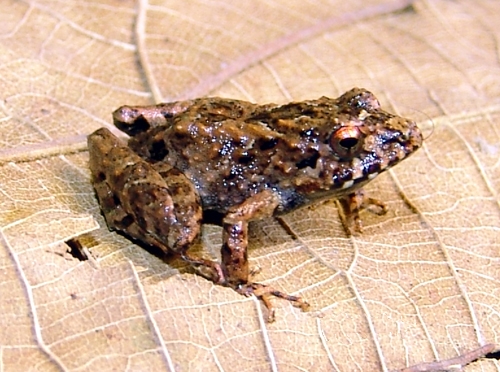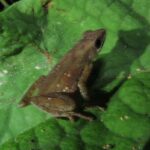- Ischnocnema verrucosa: The Hidden Jewel of the Atlantic Rainforest
- Taxonomy and Classification of Ischnocnema verrucosa
- The Hidden Habitat: Life in Brazil's Atlantic Rainforest
- Physical Characteristics: Nature's Camouflage Expert
- Behavior and Life Cycle of Ischnocnema verrucosa
- Ecological Role: A Key Player in Forest Floor Dynamics
- Threats and Conservation Status
- Cultural and Scientific Significance
- Conclusion: Protecting a Forest Jewel
Ischnocnema verrucosa: The Hidden Jewel of the Atlantic Rainforest#
In the dense mist-draped forests of Brazil’s Atlantic Rainforest, a tiny master of camouflage lies hidden—barely noticeable yet fascinatingly unique. Meet Ischnocnema verrucosa, a small terrestrial frog whose story is intertwined deeply with the rich, vibrant ecosystem it calls home. Also known as the “Warty Robber Frog,” this amphibian’s subtle existence illustrates the astonishing beauty and complexity of rainforest biodiversity.
For the curious explorer, student, or passionate conservationist, unraveling the peculiarities of this unassuming creature can reveal bigger secrets about ecological balance, evolution, and pressing conservation issues. Through understanding the remarkable life-story of Ischnocnema verrucosa, we ultimately learn to appreciate, protect, and advocate for its precious habitat.
Taxonomy and Classification of Ischnocnema verrucosa#
To truly grasp the uniqueness of Ischnocnema verrucosa, it helps first to explore its scientific roots and where it fits within amphibian diversity. Belonging to the family Brachycephalidae, Ischnocnema is a genus of direct-developing frogs, meaning that their lifecycle skips the traditional aquatic tadpole stage—an evolutionary wonder that differentiates them clearly from their water-bound relatives.
The species epithet “verrucosa” comes from Latin meaning “warty,” referring vividly to the frog’s distinctly textured, rough skin that accentuates its camouflaging skills. Closely related species in the genus often share similar body plans and lifestyles, but unique conditions within its particular microhabitat have sculpted Ischnocnema verrucosa into a specialized inhabitant of its rainforest niche.
The Hidden Habitat: Life in Brazil’s Atlantic Rainforest#
Imagine stepping into the heart of Brazil’s Atlantic Rainforest—a vast green cathedral filled with bird calls, cascading streams, and the soft dripping of moisture from a canopy above. Beneath your feet, in the leaf litter and moss-covered terrain, hides the elusive Ischnocnema verrucosa. This species is endemic to Brazil, specifically concentrated in the southeastern regions like Rio de Janeiro, São Paulo, and Minas Gerais, thriving primarily within coastal lowland and montane forests.
This frog carefully chooses locales with thick vegetation, hiding in pockets of humidity beneath fallen logs, leaf litter, roots, or near streams. Perhaps the reasons for such habitat preference lie in their physiology—their permeable skins require a constant supply of moisture for hydration. Equally essential, abundant leaf litter provides both shelter from predators and a plentiful hunting ground for their preferred insect prey.
A Micro-Habitat Specialist#
The precise microhabitats selected by Ischnocnema verrucosa have finely tuned conditions, including stable temperature, high humidity, and optimal protection from predators. This careful habitat selection emphasizes how finely specialized the frogs are, adapting ingeniously to utilize limited forest floor resources to their advantage.
Physical Characteristics: Nature’s Camouflage Expert#
Though petite in size—rarely exceeding 35 mm in body length from snout to vent—Ischnocnema verrucosa is big on remarkable adaptations. Its most distinctive feature is undoubtedly its wart-covered skin, offering effective camouflage amid the complexity of leaf litter and tree bark. Coloration ranges dramatically from varying shades of brown and gray to subtle copper or olive-green tones, with minute patches of darker pigmentation creating an almost artistic pattern, a perfect mimicry to blend seamlessly within the forest floor environment.
Adaptations for Survival#
A closer inspection reveals further fascinating specialties: specialized skin glands potentially secreting mild skin toxins, subtle yet effective leg muscles suited to jumping quickly away from danger, and large protruding eyes designed specifically to detect quick movements from predators or prey. These unique adaptations mirror an evolutionary arms race, where constant predatory pressures have shaped Ischnocnema verrucosa‘s compact yet sophisticated physique.
Behavior and Life Cycle of Ischnocnema verrucosa#
The behavior of Ischnocnema verrucosa illustrates beautifully the delicate rhythms of rainforest life. Being primarily nocturnal, these frogs emerge most actively at twilight, navigating silently through leaf litter and vegetation in search of insects like ants, small beetles, and other arthropods—prey easily accessible yet richly nutritious.
A Unique Reproductive Strategy: Direct Development#
Perhaps one of the most intriguing aspects of Ischnocnema verrucosa’s natural history is their reproduction. Unlike traditional amphibian cycles marked by aquatic tadpoles, Ischnocnema verrucosa embraces direct development—a fascinating adaptation that sees females laying eggs terrestrially in protected, damp locations, from which tiny frogs emerge fully developed, skipping the vulnerable tadpole stage entirely.
This adaptation is advantageous for a species inhabiting a terrestrial rainforest ecosystem, as reliance on water bodies is minimized, thus reducing vulnerability to fluctuations like drought conditions or predator density within streams and ponds. Parental investment, while minimal, is displayed through careful site-selection, as female frogs deliberately choose spots offering optimum moisture, protection, and likelihood of offspring survival.
Ecological Role: A Key Player in Forest Floor Dynamics#
Though modest in size, Ischnocnema verrucosa holds a prominent place within its ecological web. As diligent insectivores, these frogs help maintain the balance of forest insect populations, indirectly but notably assisting in regulating the vitality and health of vegetation and stemming the expanse of pest insects detrimental to the rainforest flora.
Concurrently, the species itself offers sustenance to various predators within the forest hierarchy, including birds, reptiles, and small mammals, thus contributing to the biodiversity and richness of its rainforest habitat. Furthermore, as amphibians, they act as vital bioindicator species—sensitive to habitat changes—signaling early warnings regarding ecosystem health and stability.
Threats and Conservation Status#
Despite their cryptic lives shielded within rainforest debris, Ischnocnema verrucosa frogs face meaningful threats, chiefly arising from habitat destruction and fragmentation. Expanding agriculture, urban development, logging, and road construction often cleave through pristine rainforest, stripping away integral habitat that the species depends on profoundly.
The International Union for the Conservation of Nature (IUCN) currently categorizes Ischnocnema verrucosa as “Least Concern,” primarily due to its relative abundance within suitable habitats. However, conservationists increasingly stress that vigilance is needed, as continued habitat fragmentation, pollution, and climate-driven moisture variation could quickly escalate risks to vulnerable populations.
Current Conservation Efforts and Future Outlook#
Efforts aimed at protecting Ischnocnema verrucosa emphasize broader initiatives to sustain and expand Brazil’s rainforest reserves, encouraging sustainable practices around vital ecosystems. Further efforts include educational programs to raise awareness among local communities, encouraging decreased deforestation and emphasizing the critical interconnectedness of species.
Cultural and Scientific Significance#
Beyond ecological importance, the presence of Ischnocnema verrucosa within Brazilian ecosystems resonates culturally, symbolizing both rainforest diversity and the urgent need for conscientious stewardship. While less extensively studied than other amphibians like poison dart frogs, research into its biology offers valuable insights for understanding evolutionary adaptations, conservation biology, and bioindicator studies—illuminating broader trends that could shape ecological research and management strategies globally.
Conclusion: Protecting a Forest Jewel#
Unobtrusive yet profoundly fascinating, the tale of the Warty Robber Frog—a shy creature hidden among leaf litter and rainforest shadows—even further stresses the pivotal need for rainforest conservation. By learning, understanding, and safeguarding creatures like Ischnocnema verrucosa, we enrich not just wildlife biodiversity but our very human connection to nature and sense of responsibility toward the planet that sustains us all.
Inspired? Engage with local and global conservation initiatives, advocate for rainforest protection, and delve deeply into the remarkable complexity that is our planet’s wild biodiversity.















